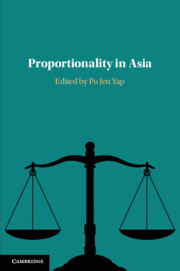Book contents
- Proportionality in Asia
- Proportionality in Asia
- Copyright page
- Contents
- Figures
- Tables
- Contributors
- Acknowledgments
- Abbreviations
- Introduction
- Part I Structured Proportionality
- 2 More Structure, More Deference
- 3 Proportionality in Taiwan
- 4 Proportionality in South Korea
- Part II Anemic / Ad Hoc Proportionality
- Part III Doctrinal Equivalents of Proportionality
- Conclusion
- Index
4 - Proportionality in South Korea
Contextualizing the Cosmopolitan Rights Grammar
from Part I - Structured Proportionality
Published online by Cambridge University Press: 18 September 2020
- Proportionality in Asia
- Proportionality in Asia
- Copyright page
- Contents
- Figures
- Tables
- Contributors
- Acknowledgments
- Abbreviations
- Introduction
- Part I Structured Proportionality
- 2 More Structure, More Deference
- 3 Proportionality in Taiwan
- 4 Proportionality in South Korea
- Part II Anemic / Ad Hoc Proportionality
- Part III Doctrinal Equivalents of Proportionality
- Conclusion
- Index
Summary
The creation of the Constitutional Court of Korea by the 1987 South Korean Constitution symbolizes a new era of democracy after three decades of military dictatorship in the country. Throughout the thirty years of the Court’s practice, proportionality has been central to its constitutional adjudication. While the structured four-stage doctrine of proportionality was adopted from German public law, this principle has been concretized and deepened through its application by the Constitutional Court. Variations and deviations have emerged in cases involving different types of constitutional rights. The Court uses proportionality to enforce civil-political rights more than socioeconomic rights. Political considerations have also played a role in cases such that the Court has been more deferential to the government, especially on national security issues. The case study of South Korea provides a vivid example of proportionality’s local contextualization and at the same time illustrates the doctrine’s capacity to function as common grammar for rights claims and debates across different segments of society and beyond state borders.
Keywords
- Type
- Chapter
- Information
- Proportionality in Asia , pp. 81 - 102Publisher: Cambridge University PressPrint publication year: 2020
- 1
- Cited by

